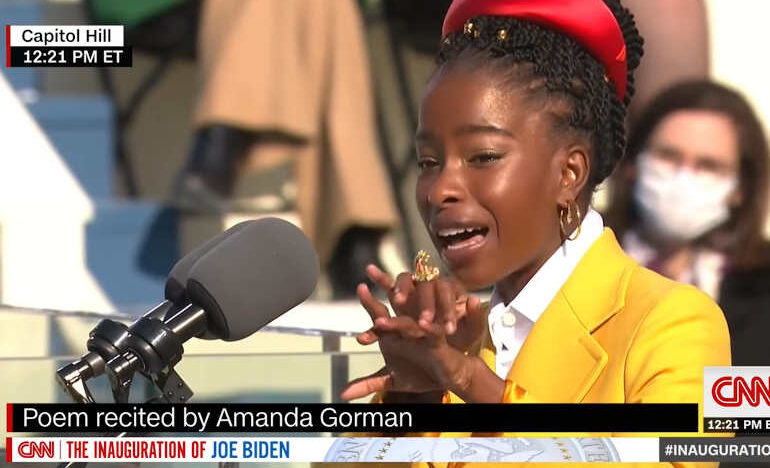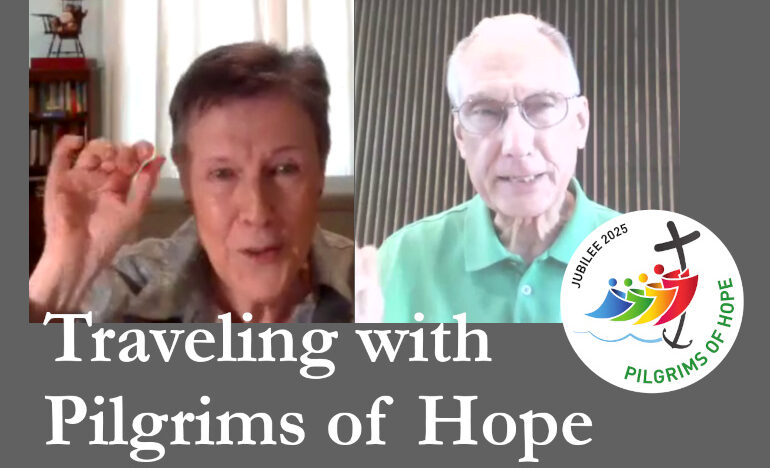Cultivating peace in our hearts: Christian and Buddhist Meditation

By Kathy Keary
Part 4. Read all the parts here.
Last week a 22-year-old rising star became a household name and a voice speaking of a brighter tomorrow. Amanda Gorman awed her audience at the inauguration bringing tears to eyes and hope to hearts.
“For there is always light if only we are brave enough to see it. If only we are brave enough to be it,” she eloquently concluded her well-crafted poem.
Her words will continue to inspire us to be part of the solution working toward a society of peace, justice, unity, and nonviolence. You can watch her full recitation here.
And so we lift our gazes not to what stands between us
But what stands before us.
We close the divide because we know to put our future first
We must first put our differences aside
We lay down our arms
So we can reach our arms to one another
We seek harm to none and harmony for all
Let the glow if nothing else say, “this is true.”
Gorman, a young Catholic activist, shines a light on the ills that surround us and calls us to our better selves much like the message of Jesus and Buddha who both issued calls to peace, unity, and love.
As we continue our series on the similarities between the teaching of Jesus and Buddha, we turn our focus to ways to cultivate peace in our hearts in the Christian and Buddhist traditions. As wisely stated by the Dalai Lama: “We can never obtain peace in the outer world until we make peace with ourselves.”
New articles in this series are posted to the website every Monday. The full series can be found here: An Invitation to Something New: The Contemplative Life. On Thursday’s we’ll send an email to remind you of the articles
In the Christian tradition, we speak of discursive meditation where one deeply reflects upon a spiritual truth. As we ponder, listen intently to the still small voice within, and embrace the emotions that arise, grace opens us to the possibility of transformation and embodiment of the fruits of the Spirit.
In this series of articles, we have looked extensively at different methods of discursive meditation. I refer you to our articles on Lectio Divina, Visio Divina, using your imagination in prayer, journaling, art journaling, contemplative photography and finding God in creation.
Centering prayer and contemplation are nondiscursive meditations where one simply rests in the divine embrace. Centering prayer and contemplation are rooted in the teachings of Jesus allowing an experience of his resurrected presence within us. When one routinely communes with the Indwelling Spirit of God, seeds of peace, love, and unity are planted and fertilized. The harvest comes when this spiritual practice informs one’s way of being in the world. I refer you to our series on contemplation for details and instruction on this practice.
The Buddha knew full well that without daily meditation, his way of being in the world would be just a philosophy or ideology. The intent of all mediation is to improve one’s self enabling the individual to be of service to others. There are two classifications of meditation in Buddhism: those that result in samatha, or calm abiding, and those designed to develop vipassana, or special insight.
Today we will explore what is meant by calm abiding.
When one practices calm abiding, the individual holds the mind on a particular object such as an image of Buddha. A mind experiencing calm abiding is free from worries, preoccupations, anxieties, and distractions. Over time with habitual practice, one experiences a reduction in the power of such emotions as anger, attachment, and jealousy. A feeling of greater harmony with the world is produced.
Note: Never miss an article published on the Renewal Center website: Sign up to receive our newsletters
The Buddha suggested a variety of ways to develop a single-focused concentration including mediating on love as the remedy to anger or ugliness as the antidote for attachment. One of the principal ways to attain calm abiding is to focus on the breath.
Thich Nhat Hanh in his book, Peace is Every Step: The Path of Mindfulness in Everyday Life suggests the following exercise to help us breathe consciously. As we focus on our inhalations and exhalations, we recite the following:
Breathing in, I calm my body.
Breathing out, I smile.
Dwelling in the present moment
I know this is a wonderful moment.
Hanh likens the effect of reciting the first line to “drinking a glass of cool lemonade on a hot day.” It calms the mind and body.
The second line speaks of a smile which “affirms our awareness and determination to live in peace and joy.” This state of being is not only of benefit to the one meditating but also to those that surround them.
The final two lines speak of the present moment – a wonderful moment. Hanh states: “It is a joy to sit, stable and at ease and return to our breathing, our smiling, our true nature. Our appointment with life is in the present moment. If we do not have peace and joy right now, when will we … ?”
In reflecting on this exercise, Hanh asserts: “Every breath we take, every step we make, can be with peace, joy and serenity. We need only be awake, alive in the present moment.”
There is so much more to say about meditation in the Buddhist tradition. We will continue this topic next week. In the meantime, with the grace offered by our prayer practices and the inspiration of Amanda Gorman’s witness, may we be a light that shines peace, unity and love into our world.
References
Chodron, Thubten. Open Heart, Clear Mind: An Introduction to the Buddha’s Teachings. Boston, Massachusetts: Snow Lion Publications, 1990.
Hanh, Thich Nhat. Peace is Every Step: The Path of Mindfulness in Everyday Life. New York: Bantam Books, 1991.
[Kathy Keary, a Precious Blood Companion and spiritual director, holds a master’s degree in theological studies and is a graduate of the Atchison Benedictine’s Sophia Center’s Souljourners Program, an intense study of spirituality and spiritual direction. Kathy believes that the divine is present and active in all of life and encourages others to be awakened to the God in all including the divine within. She enjoys accompanying others on their journey to wholeness discovering the person they were created to be.]
The image at top: Amanda Gorman read her poem “The Hill We Climb” during the inauguration of President Joe Biden on Jan. 20, 2021
We’d Like to Hear From You!
We’d like to know what you think about this article. Send us a comment using the form below. Do you have a suggestion? Is there something you want to learn more about? Send us a note.
Related

Take Nothing for the Journey
An Assembling God’s Puzzle video
By Fr. Garry Richmeier, C.PP.S.
Jesus’ teaching about what to take on a journey — nothing — is actually good advice for building trusting relationships. Don’t bring your “stuff” into the relationship; listen deeply and respec their views and situation, understand their struggles.

Pilgrims of Hope, Episode 6: Walking with Cancer Survivors
Hosted by Fr. Ron Will, C.PP.S.
We are talking with people who find hope amid difficult circumstances or bring hope to others. In this episode, Kathy Keary talks about how centering prayer, journaling and other spiritual practices helped her cope with two life threatening health issues.
Categories
Assembling God's Puzzle Coffee with Padre Cooking & Spirituality Encounters of the 4th Kind Family Matters Reflections on the Eucharsitic Prayers Spiritual Resources Taize Prayers The Contemplative Life Traveling with Pilgrims of Hope Uncategorized Videos Week of Prayer for Uhristian Unity When you need a little help
